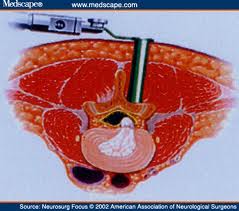Microdiscectomy is a common surgical spinal operation to remove part of the intervertebral disc which exerts pressure on some nerve root. In this way, pain is eliminated and the patient’s neurological condition improves. The patient usually resumes physical activities within two weeks.
When there is herniated intervertebral disc at the lumbar spine and rapid neurological deterioration with gradual loss of muscle strength in the limb ipsilateral to the pain, footdrop and urinary/ defecation disorders, then the patient has to be operated immediately to achieve nerve decompression from the disc herniation. In these cases, microdiscectomy is the indicated surgical technique.
The technique can be applied in three ways:
- Mini-open. The surgeon makes as small incision through which s/he uses special instruments and a microscope.
- Tubular. During this technique, the spine is approached through an opening (and not an incision) in paraspinal muscles with a tubular
 dilator inserted into the skin through a very small incision. The tubular dilator serves as a “tunnel” through which special instruments pass for applying the technique. The advantage of this method is the atraumatic approach to muscles, minimal blood loss and the impressively rapid postoperative recovery and mobilization of the patient even on the very same day.
dilator inserted into the skin through a very small incision. The tubular dilator serves as a “tunnel” through which special instruments pass for applying the technique. The advantage of this method is the atraumatic approach to muscles, minimal blood loss and the impressively rapid postoperative recovery and mobilization of the patient even on the very same day.  Endoscopic. This technique is performed with the use of a micro camera, called “endoscope”, reaching the spine through a minimal skin inscision. The surgical field is shown on a monitor situated next to the surgical table. The surgeon performs the procedure by using special instruments and advancing them while watching through the monitor.
Endoscopic. This technique is performed with the use of a micro camera, called “endoscope”, reaching the spine through a minimal skin inscision. The surgical field is shown on a monitor situated next to the surgical table. The surgeon performs the procedure by using special instruments and advancing them while watching through the monitor.
RISKS – COMPLICATIONS
As in all surgical procedures, there is the risk for infection (which is reduced in microdiscectomy), as well as risk for injury of the nerve, spinal cord or vessels of the area.
If not enough part of the bone has been removed and, therefore, there is not sufficient space for the nerve to pass through, nerve pain may recur. A small percentage of patients are likely to present the so-called “Failed Back Surgery Syndrome” (FBSS) with permanent postoperative spinal neuropathic pain, due to nerve root dysfunction of unknown aetiology despite the fact that the surgical procedure was performed perfectly well without any complications














